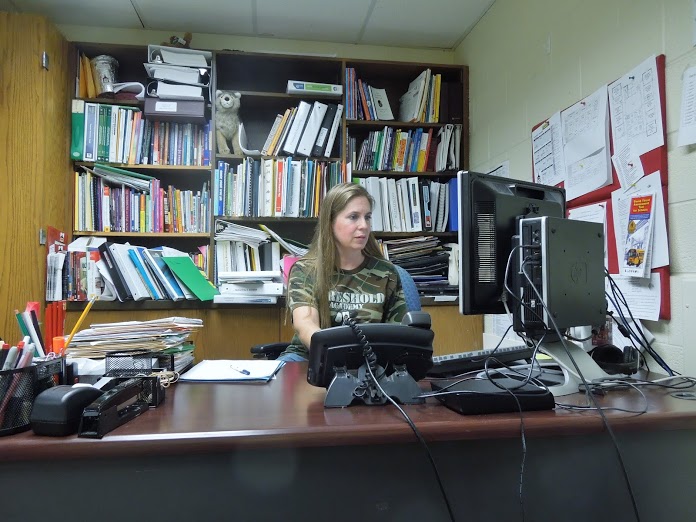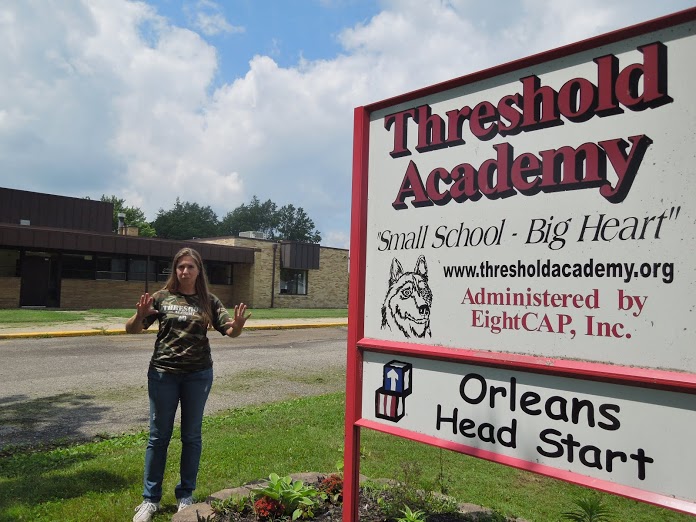A charter school for the rural poor closes
When fourth grader Ian Matthews heard his school would close the end of the last academic year, he said he asked his principal, “Why do they want to break people’s hearts?”
For Ian and more than 150 other students, Threshold Academy, a charter in rural Ionia County, had been a refuge from the constant reminders in other schools that they were different because their families were poor. More than 90 percent of Threshold students qualified for a free or reduced-price lunch.
Central Michigan University, the charter’s authorizer, declined to be interviewed on its decision to close Threshold, but in a written response said the school was “unable to consistently deliver a quality educational program.” Declining enrollment has also been cited.
For Threshold Principal Victoria Simon, the answer is more nuanced. True, Threshold’s students had not achieved the academic standards set by CMU, but their overall scores on reading and math tests were improving each year. Expecting children of poverty to score as well as middle class children in other schools was unrealistic, she said.
“CMU’s goal is to have them college ready,” she said. “Even having our kids graduate from high school is an American dream.”
After announcing it would not renew Threshold’s charter, CMU administrators offered to help parents enroll their children in other traditional public and charter schools in Ionia and Montcalm Counties.
The closing highlights the often painful choices confronting education leaders, who must balance academic progress against more intangible factors such as the need to provide a safe, stable environment for vulnerable students. The episode also taps into a debate over the wisdom of keeping high concentrations of low-income children together in school, or whether they are better off learning alongside children from middle-class backgrounds.
“I think most of these children’s parents love them dearly, but poverty does lead to neglect. They’re not being read to, they’re not being nurtured enough. Unfortunately, some of our families are changing constantly. Instability is huge.” – Threshold Academy Principal Victoria Simon.
Students like them
EightCAP, the nonprofit that managed the school, founded Threshold Academy in 1997, offering kindergarten through 5th grade specifically for the poorest children in rural Ionia and Montcalm counties.
In Ionia County, 22.8 percent of children live in poverty, a 70 percent jump between 2005 and 2011, according to the 2013 Kids Count report. In Montcalm County, the child poverty rate is 26.5 percent, a 39 percent jump since 2005.
In pulling Threshold’s charter, CMU did not “take into account the social and economic factors,” EightCAP President Dan Petersen said. “These kids are supposed to be coming to school ready to learn, and they’re not ready to learn.” Many face varied obstacles before they can begin to learn, he said, including chaotic homes, emotional and physical abuse and improper nutrition.
That said, Petersen’s and Simon’s suggestion that Threshold performed well for a school with low-income students is not necessarily borne out by analysis. In Bridge’s Magazine’s 2013 Academic State Champs report, Threshold Academy scored 94 last year. A score of 100 would mean Threshold performed at a level expected for students in their income bracket. Threshold’s score suggests its students were falling short, even when compared with students in other low-income schools.
Difficult homes
Ten percent of Threshold students lived with grandparents, about twice the state average. For nearly a third of Threshold students, their transient living arrangements met the definition of homeless under the federal McKinney-Vento Act, which ensures homeless students have access to public schools.
One student slept on a trampoline so she would be off the ground, Simon said. Another told Simon her stepfather had beaten her mother, and added, “That’s why I’ll never get married.” For Simon, the comment spoke volumes about what her students considered normal in a family: husbands beat wives; therefore, I’ll never get married.
“It does have such a dramatic impact on them in a lot of ways,” she said. “In school you have to have organized thinking and structure. If your home is in chaos, it’s hard to have organized thinking.”
She’s had students who tested positive for methamphetamines, not because they were using it, but because it was being made in their homes, she said. Once or twice a week, child protective services workers were in the school investigating reports of abuse and neglect.
“I think most of these children’s parents love them dearly,” Simon said, “but poverty does lead to neglect. They’re not being read to, they’re not being nurtured enough. Unfortunately, some of our families are changing constantly. Instability is huge.”
She estimated that 15 percent of her students had a parent who was in jail or prison. Boyfriends and stepfathers moved in and out. Only about 6 percent of the students lived in a typical two-parent home, Simon said.
Such instability can profoundly affect a child’s ability to learn, research shows.
Poverty and the “family stress, negative social and environmental characteristics” that often accompany it can interfere with development of the parts of a child’s brain critical for memory, learning and language, a panel of the American Association for the Advancement of Science reported in 2008.
Add to that the challenge of growing up in rural poverty where fewer social services or even the support of neighbors are available, and the chances for academic success can seem insurmountable. Some of Threshold’s students were the second, third or fourth generation living in poverty. About 40 percent of their mothers and 60 percent of their fathers had dropped out of high school, Simon said, increasing the risk their children would not graduate.
“We tried really hard with these kids to build up hopes and dreams and show them that they can succeed,” she said. Simon said she understood that CMU has been under pressure to improve test scores of the schools they charter, but she said the authorizer should have considered not only where Threshold’s students ended up, but where they began.
While declining to answer specific questions, CMU officials released a written statement from Cindy Schumacher, executive director of CMU’s Governor John Engler Center for Charter Schools.
CMU had gone “to substantial lengths in the last several years to help the school make the improvement required for reauthorization,” she said. “These attempts have been unsuccessful… While it is a difficult decision, CMU cannot justify authorizing a school that is unable to consistently deliver a quality educational program and meet its student achievement goals… CMU believes the decision to not reauthorize Threshold Academy is in the best interest of the parents, students and community.”
Lagging scores
In the last school year, 47.7 percent of Threshold’s students were proficient in reading on the Michigan Educational Assessment Program (or MEAP) test, and 25.8 percent were proficient in math. While that left much room for improvement, those reading scores were higher than in the Grand Rapids, Detroit and Flint public schools and 18 other CMU charter schools, but well below the state average of nearly 70 percent. Threshold’s math scores were higher than in the Grand Rapids, Lansing, Detroit and Flint public schools and 28 of CMU’s other charter schools, but below the state average of 40 percent.
Simon conceded her students’ test scores were low, “but they were good and getting better,” she said. “These are really challenged kids, and to think that they were doing that well is fantastic.”
By mid-June, she was packing up her office in the former elementary school building in Orleans, about 35 miles northwest of Grand Rapids. It’s a hamlet so small that you could miss it as you drove by on M-44. Desks, books, computers and other equipment were stacked in the hallways, ready to be sold.
Simon recalled the day this past spring when she went classroom to classroom, telling students they would not be returning this fall. She tried to put a positive spin on it, telling them they would attend schools closer to their homes and make new friends.
“It was one of the worst days of my entire life,” she said.
Parents, too, were dismayed. “I cried right along with my daughter,” Amanda Durham said. “The teachers there, they treated you as family.”
This fall, the former Threshold Academy students will be scattered through dozens of traditional public school districts and charter schools across Ionia and Montcalm counties. Some research
suggests they might be better off among middle-class students.
In 2012, the Annie E. Casey Foundation’s Kids Count project, warned that children raised in high poverty areas can develop multiple behavioral and emotional problems. There is little research, however, on whether the same can be said of children attending schools where most students are from poor families.
“It would seem to be good to mix kids of different economic levels,” said Jane Zehnder-Merrell, Kids Count project director at the Michigan League for Public Policy. While she was unfamiliar with CMU’s decision to close Threshold, she said having low-income children attend school with classmates from more-affluent families shows them that “there are opportunities, and it opens the world for these kids.”
But on the other hand, “I think another issue at play in all of this is stability for these kids,” she added. “As we open and close schools willy-nilly, I think we have to look at that component.”
Simon certainly doesn’t believe her students are better off at other schools. At Threshold, no one was teased because they were poor or their father was in prison, she said. School staff, she said, had become a surrogate family for many children. “I think it’s just another example of ignoring the problem and hoping it will go away.”
See what new members are saying about why they donated to Bridge Michigan:
- “In order for this information to be accurate and unbiased it must be underwritten by its readers, not by special interests.” - Larry S.
- “Not many other media sources report on the topics Bridge does.” - Susan B.
- “Your journalism is outstanding and rare these days.” - Mark S.
If you want to ensure the future of nonpartisan, nonprofit Michigan journalism, please become a member today. You, too, will be asked why you donated and maybe we'll feature your quote next time!


 Principal Victoria Simon packing up her office at the Threshold Academy in Orleans after Central Michigan University closed down the charter school, citing a lack of academic progress.
Principal Victoria Simon packing up her office at the Threshold Academy in Orleans after Central Michigan University closed down the charter school, citing a lack of academic progress. Threshold Academy
Threshold Academy